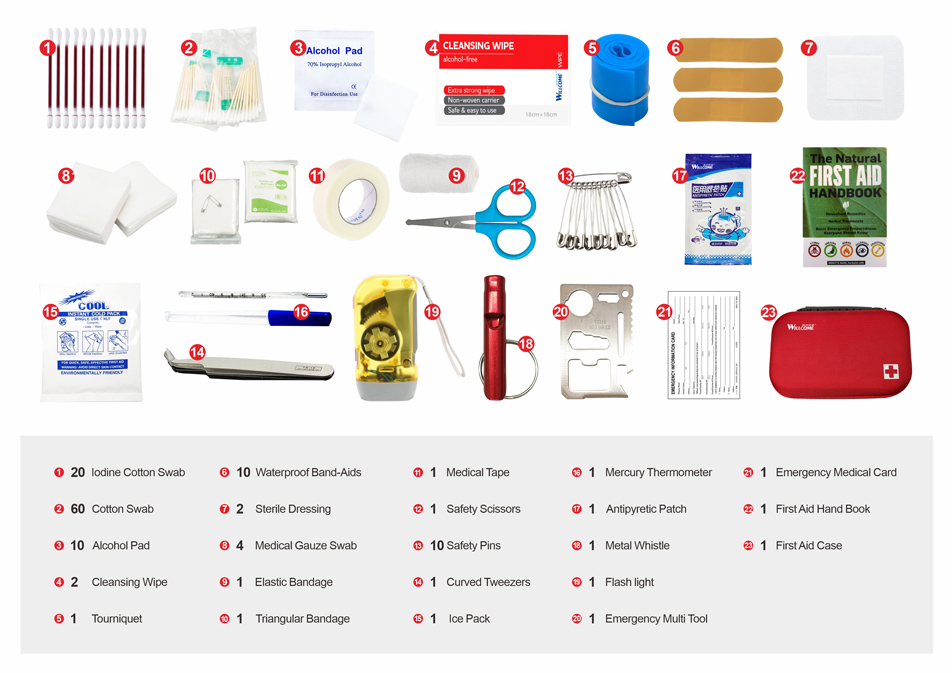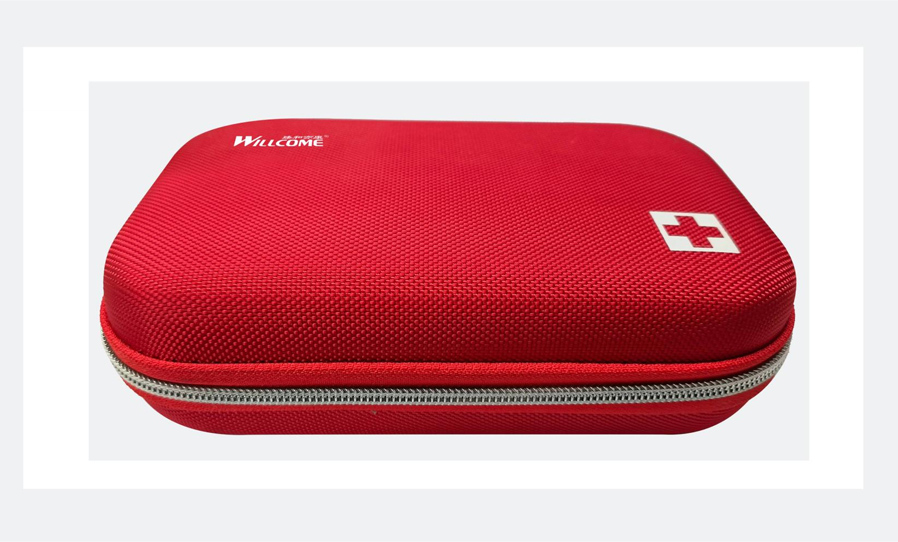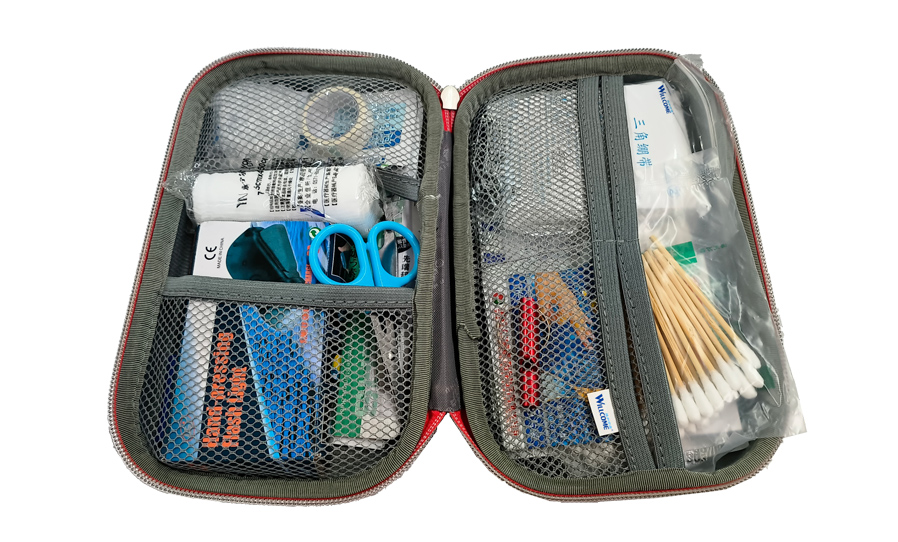A first aid kit is a collection of supplies and equipment used to provide medical treatment. The contents of a first aid kit vary widely depending on the knowledge and experience of the person assembling the first aid kit, the different first aid requirements of the area where the first aid kit may be used, and changes in legislation or regulations in a particular area. Despite these differences, the goal of a first aid kit is to provide the tools and supplies needed to resolve common injuries or emergencies until professional medical help can be obtained.
No matter your situation, if you want to keep yourself, your loved ones, or your employees safe, you must have a first aid kit ready. The equipment used in first aid can help treat minor injuries adequately at the scene without the need for a visit to a doctor, and help control injuries to minimize future harm and even save lives.


First aid kits are designed with several key features to ensure they are effective, accessible, and ready for use during emergencies. These features contribute to the functionality and efficiency of first aid kits in providing immediate care. Here are some of the notable features of first aid kits:
| Features of First Aid Kits | ||
|
|
|
Oxford Fabric Covered With Eva Three-dimensional molding, not easy to deform | Zipper High strength, high durability, smooth teeth | Waterproof Design Easy to face outdoor environment |
|
|
|
Mesh Bag Compartment Design Items are organized and easy to find & retrieve quickly. | Excellent Workmanship Exquisite sewing, even stitches | Humanized Opening And Closing Design The zipper that opens to the bottom allows the bag to lie flat for easy access. |
Compact and Lightweight: 21*12.5*5cm compact size, it’s easy to carry that fits anywhere in your car, RV, atv, yacht, boat, jeep, bike or motorcycle. Ideal for home, workplace, outdoor, travel, boat, camping, hiking and other emergency situations.
Clearly Labeled Compartments: Our first aid kits feature organized compartments with labels indicating the type of supplies (e.g., bandages, wipes, tools), making it easier to find what you need quickly in an emergency.
Customization: Some kits are designed to be customizable, allowing users to add or remove items based on personal needs, specific activities or regional risks.
Easy to open: In an emergency, time is of the essence. First aid kits are designed for quick and easy access to their contents and our first aid kits are zippered for operation even in stressful situations.
Instructions Included: Our first aid kits come with a first aid guide that provides basic first aid information and instructions on how to use the included items. This is crucial for effective and safe treatment.
Specialized Kits: There are first aid kits tailored for specific environments (outdoor, marine, workplace) or activities (hiking, camping, sports), which include specialized items suited for particular risks or injuries associated with those settings.
Sterile and Sealed Items: Items that are meant for wound care or that come into contact with broken skin, such as gauze pads and adhesive bandages, are sterile and individually sealed to prevent infection.
Product name | First Aid Kit | |
Place of Origin | China | |
Brand Name | WILLCOME | |
Disinfecting Type | EO | |
Size | 21*12.5*5 CM | |
Properties | Medical Materials & Accessories | |
Application | Medical Emergency Survival | |
Type | Medical Supplies | |
Color | Red | |
Usage | Hospital, Home, Hotel, Travelling, Public Buildings | |
OEM | Acceptable | |
Payment Terms | Western Union, T/T, L/C | |
Components | Disinfection & Debridement 20 Iodine Cotton Swab (0.15ml /pc) 60 Cotton Swab (20pcs /pack) Hemostatic Dressing 1 Tourniquet (2.5*45cm) Bandaging Aid | Diagnosis & Treatment Emergency Tools 1 Mercury Thermometer 1 Flash Light Other |
First Aid Case Material
First Aid Case: Oxford cloth EVA coated first aid kit, equipped with durable zippers for easy access, mesh functional partitioned inner bags and handles, easy to clean, highly wear-resistant, waterproof, moisture-proof, and dust-proof.
Contents Materials
Bandages & Dressings: Bandages and dressings are usually made from cotton or a cotton blend for its softness, absorbency, and breathability. Some bandages are also made from flexible, synthetic materials that can stretch and conform to the body.
Tourniquet: Made from latex-free, tear-resistant material, the blue tourniquet is strong and ultra-elastic for maximum performance. It is smooth and comfortable and does not cause any latex-induced allergic reactions.
Waterproof Band-Aids: Band-aids typically have a backing made of plastic, fabric, or latex-free material with a hypoallergenic adhesive to minimize allergic skin reactions.
Medical Gauze Swab: Made from cotton or non-woven materials, gauze is used for dressing wounds, providing a sterile barrier that allows air to circulate over the wound.
Medical Tape: Medical tape is often made from cloth, paper, or plastic. It needs to be strong enough to hold dressings in place but gentle enough to be removed without damaging the skin.
Alcohol Pad: These pads are made from a non-woven fabric saturated with an antiseptic solution, alcohol-based, to clean wounds or sanitize hands.
Ice Packs: Instant cold packs (Ice Pack) contain ammonium nitrate or urea and water in separate compartments. When the pack is squeezed, the compartments break, mixing the contents to create an endothermic reaction that cools the pack.
The materials used in first aid kits are chosen for their functionality, safety, and durability. Whether it’s the first aid case that holds everything together or the individual items used to treat injuries, each material plays a crucial role in ensuring the first aid kit serves its purpose effectively.

First aid kit is necessary in our daily life, such as in a car, outdoor sports, home. All high standards and professional emergency first aid items can be packed in it and it will certainly come in handy. No matter you are in the way or at home, after the accident, before the arrival of the ambulance, the first given to stop bleeding can reduce the mortality of the wounded.
| Applications | ||
Home In the home setting, first aid kits are used for treating common injuries such as cuts, scrapes, burns, and minor sprains. They are essential for quickly addressing accidents that occur during cooking, gardening, DIY projects, or other household activities. Having a well-stocked first aid kit at home can help manage minor injuries and prevent infections.
| Workplace Workplaces are required by law in many countries to have first aid kits accessible to all employees. The specific contents of these kits may vary depending on the nature of the work and the associated risks. For example, a construction site might need a more comprehensive kit with items to treat cuts, punctures, and eye injuries, while an office setting might require a basic kit for minor injuries and ailments.
| Outdoor Adventures Outdoor and wilderness first aid kits are designed for more remote environments where professional medical help may be hours or days away. These kits include items for treating injuries specific to outdoor activities, such as snake bites, severe cuts, and broken bones. They also contain survival tools like thermal blankets and signaling devices.
|
Travel Travel first aid kits are compact and designed to address common travel-related health issues, including motion sickness, minor wounds, insect bites, and sunburn. These kits are essential for travelers, especially when visiting areas where medical facilities may not be readily accessible.
| Transportation Having a first aid kit in a vehicle is crucial for addressing injuries resulting from car accidents or for treating minor ailments during road trips. Vehicle first aid kits typically include items to manage bleeding, fractures, and burns, reflecting the potential severity of car accident injuries.
| Schools & Hospitals In schools, first aid kits are crucial for ensuring the safety and well-being of students and staff during everyday activities and special events. In hospitals, they complement the extensive medical facilities available, ensuring that immediate care is accessible even in non-clinical areas and during community outreach efforts.
|
First aid kits are a crucial component of health and safety preparedness, but their presence alone is not enough. Knowing how to use the items in a first aid kit effectively is essential for providing proper care in an emergency. Here are general instructions and tips on how to use a first aid kit:
Read the Manual: Take the time to read this manual before an emergency occurs to understand the basics of first aid.
Ensure Safety: Before administering first aid, make sure the scene is safe for both rescuers and the victim to prevent further injury.
Assess the Situation: Quickly assess the victim’s condition to determine the most critical issues that need to be addressed first, such as severe bleeding, breathing difficulties, or signs of shock.
Call for Help: If the situation is severe or beyond your capability, call emergency services immediately. Provide them with as much information as possible about the condition of the victim.
Use the Kit: Locate and use the appropriate supplies from the first aid kit based on the injury or condition.
Follow Instructions: For specific items like cold packs or wound dressings, follow the instructions on the packaging for proper use.
Monitor the Victim: Keep the victim as comfortable as possible and monitor their condition until professional help arrives. If you’ve applied first aid treatments, check them regularly to ensure they are still effective.
Keep It Accessible: Store the first aid kit in a known, easily accessible location. In the case of a vehicle or workplace, all individuals should be aware of its location.
Regularly Check and Restock: Inspect the first aid kit regularly for expired or used items, and restock as necessary to ensure it’s always ready for use.
Customize Your Kit: Consider the specific needs of your household, workplace, or activity. Add items to your first aid kit that address those specific risks or requirements.
Get Trained: While a first aid kit is a valuable tool, proper training in first aid and CPR can significantly enhance your ability to respond effectively in emergencies. Consider taking a certified first aid course.

